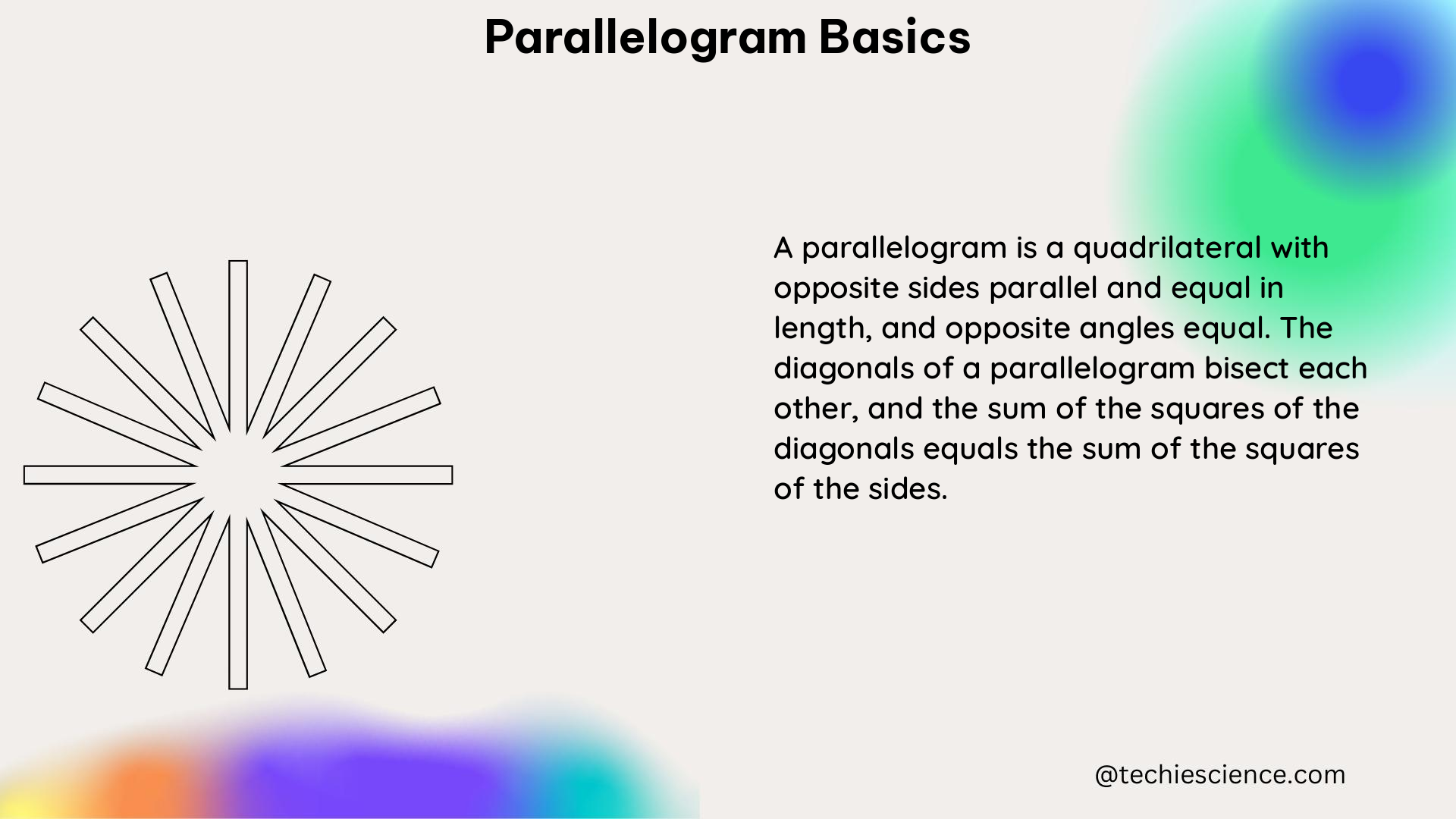A parallelogram is a two-dimensional geometric shape with four sides, where two pairs of opposite sides are parallel and equal in length. The opposite interior angles are also equal, and the angles on the same side of the transversal are supplementary, adding up to 180 degrees. The sum of the interior angles of a parallelogram is always 360 degrees.
Properties of a Parallelogram
-
Opposite Sides are Parallel and Equal: In a parallelogram, the opposite sides are parallel and equal in length. This means that if one side has a length of ‘a’, the opposite side will also have a length of ‘a’.
-
Opposite Angles are Equal: The opposite angles in a parallelogram are equal. If one angle is ‘x’ degrees, the opposite angle will also be ‘x’ degrees.
-
Consecutive or Adjacent Angles are Supplementary: The angles on the same side of the transversal in a parallelogram are supplementary, meaning they add up to 180 degrees.
-
Right Angles: If any one of the angles in a parallelogram is a right angle (90 degrees), then all the other angles will also be right angles.
-
Diagonals Bisect Each Other: The two diagonals of a parallelogram bisect each other at right angles, meaning they intersect at the midpoint of each other.
-
Diagonals Bisect the Parallelogram: Each diagonal of a parallelogram bisects the shape into two congruent triangles.
-
Parallelogram Law: The sum of the squares of the lengths of all the sides of a parallelogram is equal to the sum of the squares of the lengths of its diagonals.
Mathematically, this can be expressed as:
a^2 + b^2 + c^2 + d^2 = d1^2 + d2^2
where ‘a’, ‘b’, ‘c’, and ‘d’ are the lengths of the four sides, and ‘d1’ and ‘d2’ are the lengths of the two diagonals.
Theorems Related to Parallelograms

-
Theorem 1: Parallelograms on the same base and between the same parallel sides are equal in area.
-
Corollary: A parallelogram and a rectangle on the same base and between the same parallels are equal in area.
-
Theorem 2: The area of a parallelogram is the product of its base and the corresponding altitude.
Mathematically, the area of a parallelogram can be expressed as:
Area = base × height
Special Cases of Parallelograms
Depending on the properties of a parallelogram, it can be classified as a special case of other quadrilaterals:
- Rectangle: A parallelogram with all angles equal to 90 degrees is a rectangle.
- Square: A parallelogram with all angles equal to 90 degrees and all sides equal in length is a square.
- Rhombus: A parallelogram with all sides equal in length is a rhombus.
- Trapezoid: A parallelogram with one pair of opposite sides parallel and the other pair not parallel is a trapezoid.
Numerical Examples
- Example 1: A parallelogram has sides of length 6 cm and 8 cm. Calculate the area of the parallelogram.
Given:
– Base (b) = 6 cm
– Height (h) = 8 cm
Using the formula for the area of a parallelogram:
Area = base × height
Area = 6 cm × 8 cm = 48 cm²
- Example 2: A parallelogram has diagonals of length 10 cm and 14 cm. Calculate the lengths of the sides of the parallelogram.
Given:
– Diagonal 1 (d1) = 10 cm
– Diagonal 2 (d2) = 14 cm
Using the Parallelogram Law:
a^2 + b^2 + c^2 + d^2 = d1^2 + d2^2
a^2 + b^2 + c^2 + d^2 = 10^2 + 14^2
a^2 + b^2 + c^2 + d^2 = 100 + 196 = 296
The lengths of the sides can be calculated using the square root of the above expression:
a = b = √(296/4) = 8.6 cm
c = d = √(296/4) = 8.6 cm
Conclusion
Parallelograms are an important and versatile class of quadrilaterals in geometry, with a wide range of properties and applications. Understanding the fundamental characteristics of parallelograms, such as their side lengths, angle relationships, and area calculations, is crucial for solving various geometric problems and understanding more complex shapes and structures.
References
- Parallelogram Properties and Formulas
- Parallelogram Proofs and Theorems
- Proofs for Parallelograms
- Quadrilaterals in GRE Quantitative Reasoning

The lambdageeks.com Core SME Team is a group of experienced subject matter experts from diverse scientific and technical fields including Physics, Chemistry, Technology,Electronics & Electrical Engineering, Automotive, Mechanical Engineering. Our team collaborates to create high-quality, well-researched articles on a wide range of science and technology topics for the lambdageeks.com website.
All Our Senior SME are having more than 7 Years of experience in the respective fields . They are either Working Industry Professionals or assocaited With different Universities. Refer Our Authors Page to get to know About our Core SMEs.